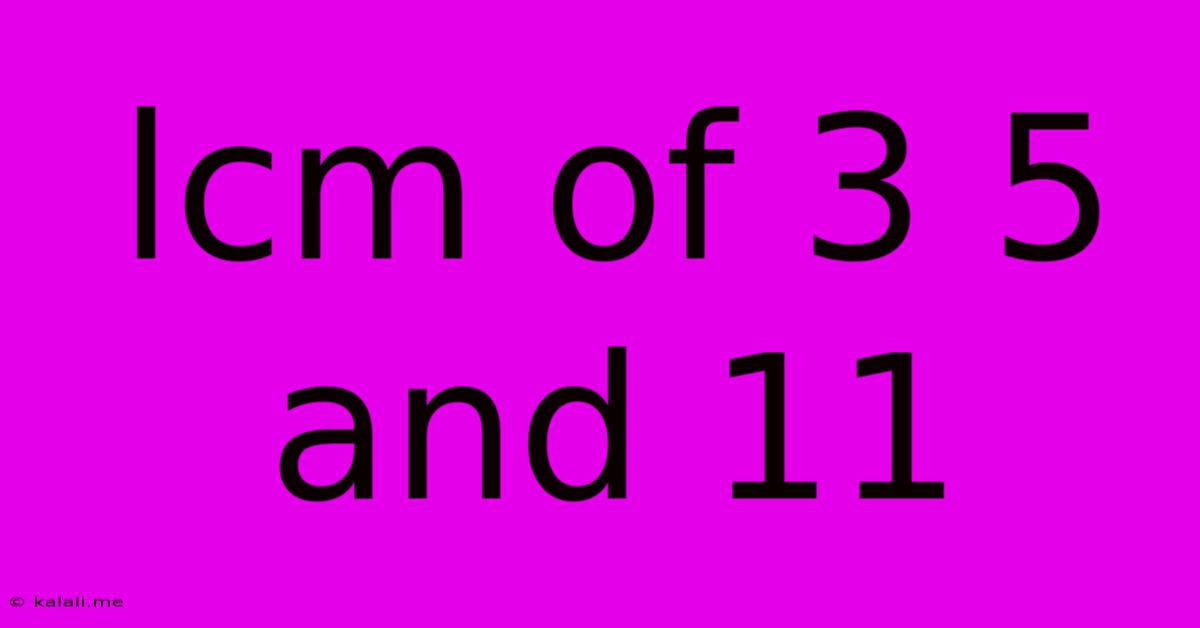Lcm Of 3 5 And 11
Kalali
Jun 14, 2025 · 3 min read

Table of Contents
Finding the Least Common Multiple (LCM) of 3, 5, and 11
This article will guide you through calculating the least common multiple (LCM) of 3, 5, and 11. Understanding LCM is crucial in various mathematical applications, from simplifying fractions to solving problems involving cycles and periodic events. We'll explore different methods, making this concept accessible to all levels of mathematical understanding.
What is the Least Common Multiple (LCM)?
The least common multiple (LCM) is the smallest positive integer that is divisible by all the numbers in a given set. In simpler terms, it's the smallest number that all the numbers in your set can divide into evenly, leaving no remainder. This is different from the greatest common factor (GCF), which is the largest number that divides evenly into all numbers in a set. Understanding both LCM and GCF is essential in number theory and algebra.
Methods for Finding the LCM of 3, 5, and 11
We'll explore two common methods to find the LCM of 3, 5, and 11:
1. Prime Factorization Method:
This method involves breaking down each number into its prime factors. Prime numbers are numbers greater than 1 that are only divisible by 1 and themselves (e.g., 2, 3, 5, 7, 11, etc.).
-
Step 1: Prime Factorization:
- 3 = 3
- 5 = 5
- 11 = 11
-
Step 2: Identify the Highest Power of Each Prime Factor: Since each number is already a prime number, the highest power of each prime factor is simply itself.
-
Step 3: Multiply the Highest Powers Together: 3 x 5 x 11 = 165
Therefore, the LCM of 3, 5, and 11 is 165.
2. Listing Multiples Method:
This method is more straightforward for smaller numbers but can become cumbersome with larger numbers.
-
Step 1: List the Multiples: List the multiples of each number until you find a common multiple.
- Multiples of 3: 3, 6, 9, 12, 15, 18, 21, 24, 27, 30, 33, 36, 39, 42, 45, 48, 51, 54, 57, 60, 63, 66, 69, 72, 75, 78, 81, 84, 87, 90, 93, 96, 99, 102, 105, 108, 111, 114, 117, 120, 123, 126, 129, 132, 135, 138, 141, 144, 147, 150, 153, 156, 159, 162, 165,...
- Multiples of 5: 5, 10, 15, 20, 25, 30, 35, 40, 45, 50, 55, 60, 65, 70, 75, 80, 85, 90, 95, 100, 105, 110, 115, 120, 125, 130, 135, 140, 145, 150, 155, 160, 165,...
- Multiples of 11: 11, 22, 33, 44, 55, 66, 77, 88, 99, 110, 121, 132, 143, 154, 165,...
-
Step 2: Identify the Smallest Common Multiple: The smallest number that appears in all three lists is 165.
Therefore, the LCM of 3, 5, and 11 is 165.
Conclusion:
Both methods effectively determine the LCM of 3, 5, and 11. The prime factorization method is generally more efficient for larger numbers, while the listing multiples method is suitable for smaller sets. Understanding how to calculate the LCM is a fundamental skill with applications across various mathematical fields. Remember to choose the method that best suits the complexity of the numbers involved.
Latest Posts
Latest Posts
-
How Many Unpaired Electrons Does Mg Have
Jun 14, 2025
-
A Group Of Stars Is Called
Jun 14, 2025
-
What Is The Unit For Strain
Jun 14, 2025
-
What Is The Hybridization Of The Central Atom In Pcl3
Jun 14, 2025
-
Which One Of The Following Is Not A Supply Chain Strategy
Jun 14, 2025
Related Post
Thank you for visiting our website which covers about Lcm Of 3 5 And 11 . We hope the information provided has been useful to you. Feel free to contact us if you have any questions or need further assistance. See you next time and don't miss to bookmark.